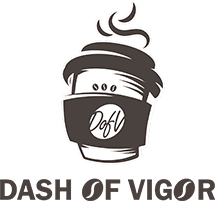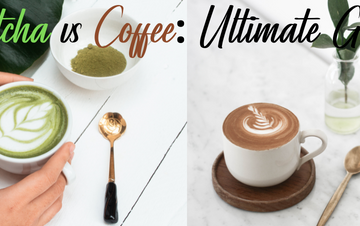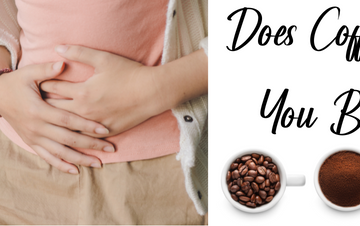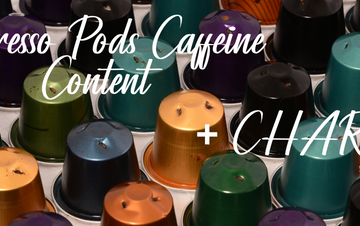How Many Ounces in A Cup of Coffee?
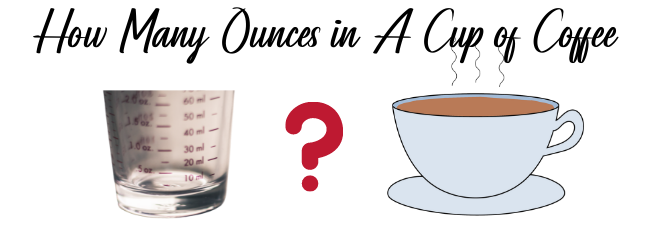
How many ounces in a cup of coffee is a question that can have multiple answers depending on the cafe and region. But let`s try to figure it out together.
There are 6 ounces of coffee in a standard cup of coffee. This is a measurement of the liquid content of the coffee that has been brewed, and it is not the volume of the actual cup.
What is the golden ratio? Add 1 to 2 tablespoons of ground coffee for every 6 ounces of water.
6 ounces is equivalent to 1 “cup” in a standard coffee maker. It’s based on the Golden Ratio of freshly brewed coffee.
Although the volume of a “cup” measurement equals 8 fluid ounces, in the US the majority of the world is using the metric system. There are distinct “cup” measurements and brewing methods. Starbucks has its own cup sizes (Short, Tall, Grande, Venti, Trenta).
Understanding that a cup of coffee isn’t the same as a standard measure of a cup can be the initial step in understanding what this is all about. However, there is beyond measuring the coffee that we will discuss.
TABLE OF CONTENTS:
- What Is Precisely an Ounce?
- Coffee Cups
- The History Behind It All
- Getting The Ratio Right
- How Many Ounces in A Cup of Coffee?
- What Is the Best Coffee to Water Ratio to Use?
- Why Is Measuring Coffee Beans with A Cup Difficult?
- Standard Coffee Sizes
- What Is the Most Popular Coffee Cup Size?
What Is Precisely an Ounce?
Most people in the United States bake and cook using an 8-ounce cup, the standard cup measurement. This refers to a customary cup. It is just eight ounces of whatever fluid you are using in this instance. 240 ml is the standard measurement for labeling reasons, slightly more significant than the precise conversion of 236.6 ml. Pouring liquid from a one-cup bottle into a measuring cup fills slightly below the cup mark.
You need to know that a measuring cup will measure things in standard dimensions and fluid ounces. If you’re unsure, look for containers labeled in ounces of healthy liquids rather than regular cups.
Other nations have distinct norms, which should be considered as well. For example, in Canada, Australia, and New Zealand, one cup refers to a metric cup or 250 ml of liquids. While metric cups are uncommon in the US, it’s best to be prepared just in case.
Coffee Cups
Although you should better know the cup proportions by now, coffee cups will surprise you. A cup of freshly made coffee is usually four ounces, half the size of a typical cup. However, suppose you are making 4 oz of coffee. Because the coffee grounds absorb some water throughout the brewing process, you will need 5 oz of water.
A carafe with two lines is standard on most coffee equipment, such as automatic drip coffee makers. One of them is for measuring the brewed coffee. The other is for measuring the filtered water. A carafe of drip coffee made with 20 oz of water, for example, will provide around 16 oz of coffee after it has completed its brewing process. To prepare two 8 oz coffee cups, you need to boil 16 oz of coffee, which means 20oz of water.
The History Behind It All
Like most people, you may think that all of this is a little too difficult when all you really want to know is how many ounces in a cup of coffee are. Its origins may be traced to the early 1970s when prominent coffee manufacturer Mr. Coffee launched a coffee maker on the market. It made use of 5 oz of water as the standard measurement. Carafe markings of four and five ounces made it easier to compare pre-brew water levels with brewed coffee levels throughout the brewing process. The fact that the model was successful led to an influx of imitators. Regrettably, this traditional but confusing method of measuring a cup of coffee has remained in use.
Getting The Ratio Right
You may be asking why it is essential to know how many ounces in a cup of coffee are. It is necessary information since it helps you determine the proper ratio of coffee to water. It is vital to know what a “cup” really means to avoid damaging your brew by using the wrong proportion of water in coffee grounds while making a cup of coffee. However, rather than merely adjusting the quantity of coffee or water you use, these two factors determine whether your coffee is delightful or unpleasant to drink.
The good news is that there are various methods for measuring your cup of coffee. Instead of using a measuring cup, you may use a scale to acquire a better ratio and be more precise with your calculations. The ideal coffee to water ratio is 1.5-2 g of whole bean coffee per 28 g of water. That will help you avoid complications with cups and other serving vessels. Suppose you want to create 16 ounces of coffee or 2 regular eight-ounce cups of coffee. In that case, you will need between 26 and 32 grams of coffee, depending on how strong you prefer your coffee. Because entire beans don’t sit evenly in a measuring cup, you’ll have better success weighing them than attempting to do so with a measuring cup.
How Many Ounces in A Cup of Coffee?
The number of ounces included in a regular coffee cup will vary depending on the standard or metric systems. In the United States, a cup equals 8 fluid ounces when measured by the standard system. For coffee, on the other hand, many people choose to use the metric system since it is more convenient. Using the conversion factor of ounces to milliliters, one fluid ounce = 28.41 ml.
What Is the Best Coffee to Water Ratio to Use?
Some people may be perplexed as to why the size of a coffee cup is essential at all. It is significant since you must achieve the proper ratio. A “cup” is an important concept to understand while attempting to prepare a cup of coffee from scratch.
If you don’t, you can end up with too much water and too few coffee grounds, which will throw off your ratio. It is not the quantity of water or the number of coffee beans you use in your coffee maker that determines the quality of the coffee. The balance between the two determines how good your coffee tastes.
There are a variety of additional methods for measuring your coffee, fortunately. Instead of using a measuring cup, a scale may be used. To get the desired strength in your coffee, you should strive for a coffee to water ratio of 1.5 to 2 grams of whole-bean coffee per 28 grams of water.
As a result, if you want to brew 16 fluid ounces of coffee (equivalent to two “normal” cups), you will need between 26 and 32 grams of coffee. A 16 fluid ounce coffee cup is considered typical in the United States for coffee mug size! Alternatively, you may divide the recipe between two people and create two 8-ounce cups.
If you want to ensure your coffee has the appropriate consistency, you should use a scale. You’ll have difficulty measuring 1 “cup” of coffee beans, which is especially true if you’re using whole coffee beans. Because coffee beans do not settle uniformly in the measuring cup, there will be some empty spaces in your cup when you measure your coffee.
Why Is Measuring Coffee Beans with A Cup Difficult?
It is usually preferable to measure by weight rather than volume when weighing coffee beans since weight is more accurate. Whatever method you choose to make your coffee, a kitchen scale can help you attain a more precise coffee to water ratio and better-tasting coffee.
Inconsistent and, in some situations, poor-tasting coffee might occur from using a measuring cup to estimate your coffee beans because of the exposed regions in the cup during the process. This is because coffee beans come in various sizes and shapes and will not measure uniformly.
When you pour entire coffee beans into your measuring cup, you will end up with slightly less than a cup of coffee. That will restrict the amount of coffee you use and may skew the ratio. Using a measuring cup to estimate coffee grinds is more straightforward. But a kitchen scale will create a more exact result. It’s also easier to use a kitchen scale to guarantee a consistent brew every time.
Standard Coffee Sizes
Most Starbucks’ coffee offerings, including filter coffee and Americano, latte, cappuccino, and mocha, are available in tall, grande, and venti quantities. Most coffee shops and coffee makers that choose brew sizes will also supply a range of standard sizes, making it easy to traverse the marketplace. А shot of espresso is much smaller than a cup of espresso. Because of this, it is typically referred to as a shot rather than a cup of espresso.
When you request a standard-sized cup of coffee, you will usually be given an 8-ounce cup of the beverage. According to the manufacturer, a ‘travel mug’ size on the overwhelming majority of coffee machines that provide several brew sizes would generally correspond to a 16 oz cup of coffee. Of course, you may request a different serving size if you want. In that case, you may use a manual coffee brewing method such as pour-over coffee. It will give you complete control over how much coffee per cup is served.
Coffee cups, regular cups, and size conversions are all terminology that might be confusing. Coffee is usually provided in 8 oz servings, yet machines may only deliver 4 oz of the beverage in certain situations. Overall, the critical reason for knowing the size of your cup of coffee is to ensure that you get the proper ratio. This way, you will be able to make a fantastic cup of joe every morning.
What Is the Most Popular Coffee Cup Size?
According to a 2020 survey, more than half of all coffee users in the United States consume their beverage in 12-16 oz cups.
For the vast majority of people, a cup of coffee that holds less than 8 fl oz is too tiny. Larger, more casual coffee cups are trendy among Americans. Except for the tiny espresso cups, even fast-food coffee chains like Starbucks and Dunkin Donuts don’t provide coffee in cups smaller than 8 ounces or 12 ounces.
The size of a coffee cup varies greatly depending on where in the globe you live. Small 2-3 ounce cups of coffee were offered throughout the Balkans, Middle East, and Ethiopia. Australia and the United Kingdom provide dine-in coffee cups that range from 160 to 200 ml in volume.
Fast-food coffee culture, which promotes huge cups, has increased the usage of American-sized mugs in various countries. There are also regional variations in the size of cooking mugs. In the United States, a typical cup is 8 fl oz (240 ml). Although it is 6.7 fl oz (200 ml) in Japan and Australia, where it is 8.4 fl oz (250 ml).
